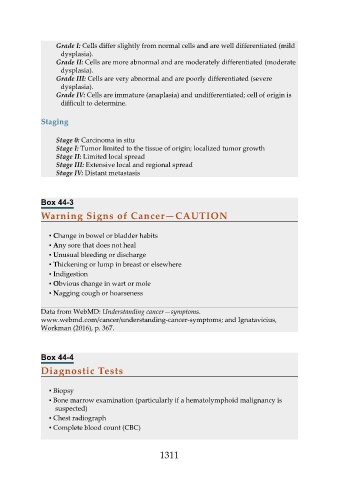Page 1311 - Saunders Comprehensive Review For NCLEX-RN
P. 1311
Grade I: Cells differ slightly from normal cells and are well differentiated (mild
dysplasia).
Grade II: Cells are more abnormal and are moderately differentiated (moderate
dysplasia).
Grade III: Cells are very abnormal and are poorly differentiated (severe
dysplasia).
Grade IV: Cells are immature (anaplasia) and undifferentiated; cell of origin is
difficult to determine.
Staging
Stage 0: Carcinoma in situ
Stage I: Tumor limited to the tissue of origin; localized tumor growth
Stage II: Limited local spread
Stage III: Extensive local and regional spread
Stage IV: Distant metastasis
Box 44-3
Warning Signs of Cancer—CAUTION
▪ Change in bowel or bladder habits
▪ Any sore that does not heal
▪ Unusual bleeding or discharge
▪ Thickening or lump in breast or elsewhere
▪ Indigestion
▪ Obvious change in wart or mole
▪ Nagging cough or hoarseness
Data from WebMD: Understanding cancer—symptoms.
www.webmd.com/cancer/understanding-cancer-symptoms; and Ignatavicius,
Workman (2016), p. 367.
Box 44-4
Diagnostic Tests
▪ Biopsy
▪ Bone marrow examination (particularly if a hematolymphoid malignancy is
suspected)
▪ Chest radiograph
▪ Complete blood count (CBC)
1311

